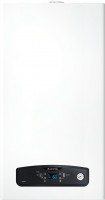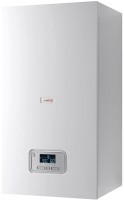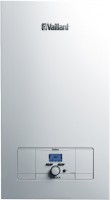Common error codes in gas heating boilers

Anarchy reigns in the principles of error codification of heating boilers — each manufacturer sets its own rules for encrypting fault codes. It is generally accepted to use a combination of letters of the Latin alphabet and numbers from 0 to 9 to encode errors. Most often, to interpret a particular code, it is enough to resort to the help of technical documentation for the product. Usually, it contains tables with the name of the error, the cause of the malfunction and a list of measures taken to eliminate it.
Problems with boilers usually arise against the background of untimely maintenance of components and aggregates, therefore it is necessary to make it a rule from time to time to arrange a thorough check of the heating equipment by the involved specialists. It is also worth contacting them for all problems with boilers. With the exception of some elementary troubles that can be solved on their own.
In gas heating boilers, the gas burner requires close attention, since it is she who is clogged most often. It is also important to periodically clean the internal surfaces of the working chambers from contamination and maintain the chimney. It is noteworthy that the risk of failure or malfunction in two-circuit products is several times higher than in single-circuit models. The reason is the more complex design of the first type of devices, besides, the water heater in the composition of such a boiler has to work all year round without a break.
Some heating units are not equipped with a display, however, they are also amenable to troubleshooting. In case of a problem, coloured light bulbs light up or blink on the panel of such boilers. Their background is disclosed in the accompanying documentation for the device. Do not be lazy to look through it — the study of the technical passport of the model will go exclusively for the future.
The following is a list of the most common error codes with their descriptions for six major players in the heating systems market. The names of the manufacturing companies in the list are arranged in alphabetical order:
BAXI boilers
E 01 — failed to ignite the gas burner in normal mode. The error belongs to the category of general — the most diverse factors lead to its appearance: non-compliance of the inlet gas pressure with the established norms, non-compliance with the polarity of the boiler connection, malfunction of the gas valve or electronic board, etc.
E 02 — operation of the emergency overheating thermostat. Most often, boiler overheating is caused by clogging of the heat exchange circuit. Less often, the problem should be looked for in the thermostat or temperature sensor on the heating supply.
E 03 — problems with the supply or discharge of air from the combustion chamber. In boilers with an open chamber, an error with almost 100 percent probability indicates a lack of proper traction, but in turbocharged models everything is not so clear: the reason for the error E 03 flashing on the screen may be both the non-start of the fan and the banal accumulation of condensate in the tubes.
E 05 — malfunction of the temperature sensor on the supply of the heating circuit. Often, when this error occurs, the aforementioned sensor is asked for replacement.
E 06 — the DHW system temperature sensor is faulty. Similar to the previous paragraph.
E 10 — unacceptable pressure in the heating system. The error "pops up" due to low water pressure in the circuit, poor contact between the sensor and the control board, or the cause of its occurrence is a malfunction of the minimum pressure switch. In the vast majority of cases, the problem is nullified when filling the system with a coolant.
E 25 — exceeding the maximum boiler temperature. The reason should be sought mainly in the poor circulation of the coolant or in the malfunction of the temperature sensor of the heating system, which is installed at the outlet of the primary heat exchanger.
E 35 — parasitic flame (intermittent). The code can be seen on the boiler display in case of a malfunction of the electronic board, as well as an incorrect location of the flame detector electrode.
E 40, E 41 — clogging of the chimney or too low gas inlet pressure. The occurrence of a tandem of these errors is influenced by many factors: from a really low supply pressure of "blue fuel" to a malfunction of the gas valve.
E 96 — low voltage of the supply circuit (less than 170 V). If the error appears with enviable regularity, it would be useful to get a voltage stabilizer in order to equalize its value and protect the device from possible power surges in the power supply network.
E 00, E 99 — internal error of the electronic board.
Bosch boilers
For the Bosch Gaz 6000 series:
A7 — malfunction of the hot water circuit temperature sensor. The sensor must be checked and replaced if necessary.
Ad — the boiler temperature sensor is not defined. You will need to check the sensor itself and the connecting wire.
C1 — low fan speed. It can be caused by both low voltage in the power supply network and related problems in the flue gas exhaust system.
C4 — The differential pressure switch does not switch off when the fan is switched off.It is necessary to inspect this relay.
C7 — fan malfunction. Ways to solve the problem: checking the operability of the fan and its wires with plugs. If necessary, the fan is replaced.
E2 — temperature sensor malfunction on the supply line (breakage). This error usually results in damage or short circuit of the aforementioned sensor.
E9 — operation of the temperature limiter in the heat exchanger. The E9 code appears on the boiler screen due to many factors — from damage to the temperature limiter to problems in the heating circuit.
EA — no flame detected. This is one of the most common mistakes in Bosch heating boilers. There are a lot of reasons for the error, as well as ways to solve the problem. But first it is better to check the opening of the gas tap, the gas supply pressure and the flue gas exhaust system. Doesn't help? We start cleaning the heat exchanger and, if necessary, change the gas fittings.
F7 — the boiler detects the flame when switched off. The reason should be sought in the contamination of the electrodes, in parallel with which it is desirable to check the humidity of the control board.
The FA — boiler detects the flame when the gas supply is blocked. The gas fittings and the flue gas exhaust system are subject to inspection.
 |
| Bosch gas boilers are in harmony with most modern interiors. |
For the ZSC/ZWC series:
A7 — malfunction of the temperature sensor of the hot water circuit (DHW). The problem is often in it, i.e. the sensor needs to be replaced.
A8 — the connection to the BUS bus has been interrupted. The problem is intended to be eliminated by checking the connecting cable and regulators.
A9 — incorrect installation of the DHW temperature sensor. If this error occurs, it is worth checking the mounting area of the sensor and reconnecting it using a heat-conducting paste.
Ad — sensor of the boiler is not detected. It is necessary to diagnose the sensor or replace it.
C1 — during the operation of the boiler, the differential pressure switch was opened. Diffrelle, exhaust device and connecting pipes are subject to inspection.
C4 — The differential pressure switch does not switch off when the fan is switched off. It is necessary to inspect this relay.
C6 — the differential relay does not open. The first point of the programme, if an error occurs, is to check the relay and the flue gas outlet pipe.
d4 — too much temperature difference. When the code appears, you need to pay attention to the circulation pump, bypass hose and check the pressure in the system.
EA — no flame detected. This is one of the most common mistakes in Bosch heating boilers. There are a lot of reasons for the error, as well as ways to solve the problem. But first it is better to check the opening of the gas tap, the gas supply pressure and the flue gas exhaust system. Doesn't help? We start cleaning the heat exchanger and, if necessary, change the gas fittings.
F0 — internal problem. In this case, it is necessary to diagnose the electronic board.
F7 — the boiler detects the flame when switched off. The reason should be sought in the contamination of the electrodes, in parallel with which it is desirable to check the humidity of the control board.
The FA — boiler detects the flame when the gas supply is blocked. The gas fittings and the flue gas exhaust system are subject to inspection.
Buderus boilers
Errors that occur in Buderus gas boilers are encrypted in a special way. First, the main code is indicated (which fault has occurred), then an additional code combination (this number uniquely identifies the fault signal), and at the end the fault class is indicated. There are several classes:
- O — operating messages during normal boiler operation;
- R — non-blocking malfunctions, in the event of which the system continues to work;
- B — blocking malfunctions that lead to a time-limited shutdown of the heating system;
- V — locking malfunctions that block the operation of the heating system.
 |
| A special error codification system is provided for Buderus boilers. |
The list of possible errors in Buderus boilers is very extensive. However, most often the user sees such fault codes on the service screen:
2E 357 O — the air removal function is active, or the temperature of the feed stream is rapidly increasing.
3C 217 V — the fan does not work. It is important to determine at what stage the problem occurs: if the fan starts, but the relay does not click, the problem lies in the supply pipes or clogging of the chimney. If the fan does not start at all, you need to check whether the voltage is applied to it. If the fan is running and there are no problems with the chimney, it is necessary to check the pneumatic relay. Its permanently closed contacts or their opening during the operation of the burner will also be regarded by the security system as a malfunction.
4C 224 B V — operation of the heat exchanger temperature limiter or the flue gas temperature limiter. Both sensors are examined, the power cable to them, and if the pressure in the system is insufficient, the boiler needs to be energized. Also, the problem may be caused by problems with the circulation of the coolant or the occurrence of an air plug.
4Y 351 B V — temperature sensor breakage. Ringing contacts and installing a new part helps to overcome the malfunction.
6A 227 B V — flame is not recognized. In most cases, it is better to entrust the solution of the ignition problem to specialists. The simplest thing an ordinary user can do is a visual inspection of the combustion chamber and electrodes for contamination. If necessary, they are cleaned. And if the boiler is ignited, but after a while it goes out, troubles are often associated with the failure of the electronic board.
Boilers Hotspot-Ariston
101 — operation of the overheating protection system. There are several main reasons for the appearance of the error code: increased pressure at the outlet of the gas valve, contamination of the coarse filter, poor circulation of the coolant in the heating system, poor permeability of the heat exchanger due to scale formation, malfunction of the circulation pump.
108 — the pressure drop in the heating circuit is below the minimum. There is probably a leak in the system somewhere.
109 — the pressure in the system has risen above 3 bar. The error sometimes occurs in the second heat exchanger of double-circuit boilers. Due to a malfunction, hot and cold water are mixed in it, which leads to an increase in pressure.
201 — there is no contact with the sensor on the supply to the DHW circuit. You will need to tighten the contacts or replace the sensor.
302 — loss of communication with the display and the electronic module. The problem often lies in the wiring.
501 — no flame during ignition. An error from the category of the most common. The first and most important thing is to check if the gas supply tap is not blocked. Also, the malfunction sometimes manifests itself due to a breakdown of the flame sensor.
SP3 (5P3) — flame separation. With enviable regularity, the problem occurs in the area of the coaxial chimney. In order to negate it, adjust its position and clear it of debris.
601 — lack of traction in the system. If the sensor is working correctly, you will have to clean the chimney.
604 — low fan speed.
6P1, 6P2 — delay in closing the contacts of the air pressure switch. Occurs due to damage to the Venturi tube. The difference between the codes is that 6P2 is displayed when the boiler is running, and 6P1 — when trying to ignite with an already damaged tube.
Protherm boilers
F00/01 — malfunction of the heating temperature sensor. The sensor must be checked and replaced if necessary.
F13 — boiler sensor malfunction. Similar to the previous paragraph.
F20 — overheating malfunction (temperature over 97 °C). To eliminate the error, you need to check the circulation pump, make sure that the heating taps and bypass valve are open, and also diagnose the heat filter.
F22 — there is no coolant in the boiler. Fill up the system and make sure that there are no leaks in it.
F24 — malfunction of the coolant circulation. The problem in this case lies both in the pump and in the closed heating taps.
F26 — lack of necessary current through the gas valve motor. The stepper motor needs diagnostics and subsequent replacement.
F28/29 — no flame was detected during ignition and no flame loss during burner operation. Here everything is like peers — you need to check the opening of the gas tap yourself, and to solve more serious problems you will have to seek help from qualified specialists.
F84 is the constant temperature difference between the feed and return sensor. The sensor is most likely to be replaced.
Vaillant boilers
F.10/11 — short circuit in the feed/return sensor. The sensor needs to be diagnosed or replaced.
F.13/14 — short circuit in the hot start sensor. Similar to the previous paragraph.
F.22 — insufficient amount of water in the system or its complete absence. In the vast majority of cases, the problem is nullified when filling the system with a coolant.
F.28 — a problem in the electronic board.
F.29 — the gas burner does not light up. One of the list of the most well-known problems with gas boilers. Its appearance is influenced by non-compliance of the gas inlet pressure with the established standards, non-compliance with the polarity of the boiler connection, malfunction of the gas valve or electronic board, etc.
F.36 — the release of gaseous gorenje products into the room. The error occurs when the duct or gas outlet is closed. It is manifested due to poor traction and ventilation, as well as due to the increased temperature in the room where the boiler is installed.
F.61 — an error in the control of gas valves. The essence of the problem lies both in the valves themselves, and the wiring to them, or in the electronic control board.
F.75 — the gas boiler pump is running, but the pressure does not change. In order to correct the situation as quickly as possible, the adjustable bypass, pressure sensor, circulation pump and the correct connection to the expansion tank line are subject to verification.
A complete list of errors and possible ways of troubleshooting, as mentioned above, should be found in the accompanying paper documentation for the heating boiler.
Warmth in your homes!
Who said that a laptop can't be compact, powerful and affordable at the same time?
A selfie stick is no longer a luxury or a gadget for hipsters, but a necessary thing for every smartphone owner.
When you don't have to wait long to transfer a large archive of photos.
The best in its category electric chain saws for any low-cost.
Automatic blood pressure and pulse tonometers with cuff attachment on the forearm.


































































































































